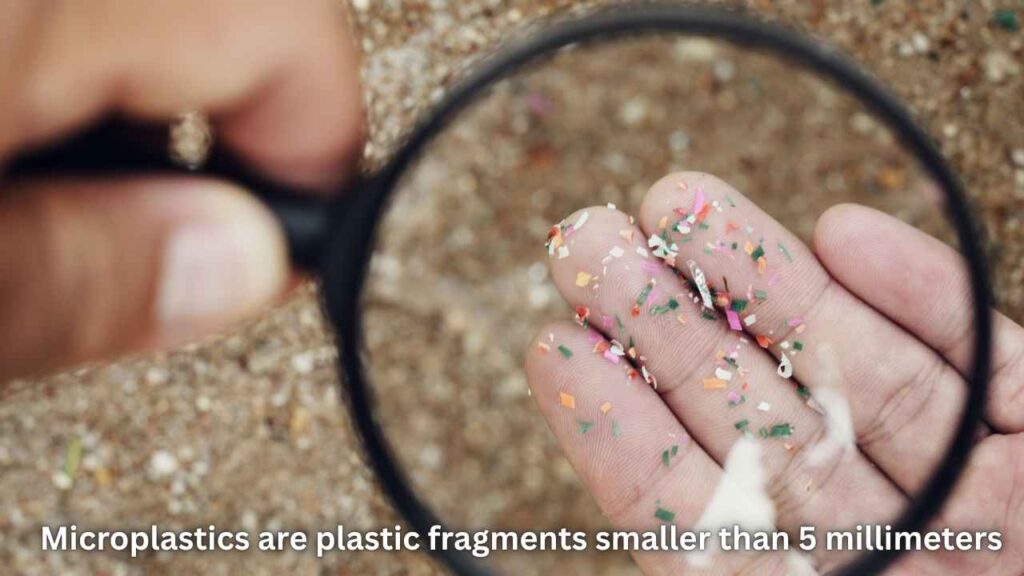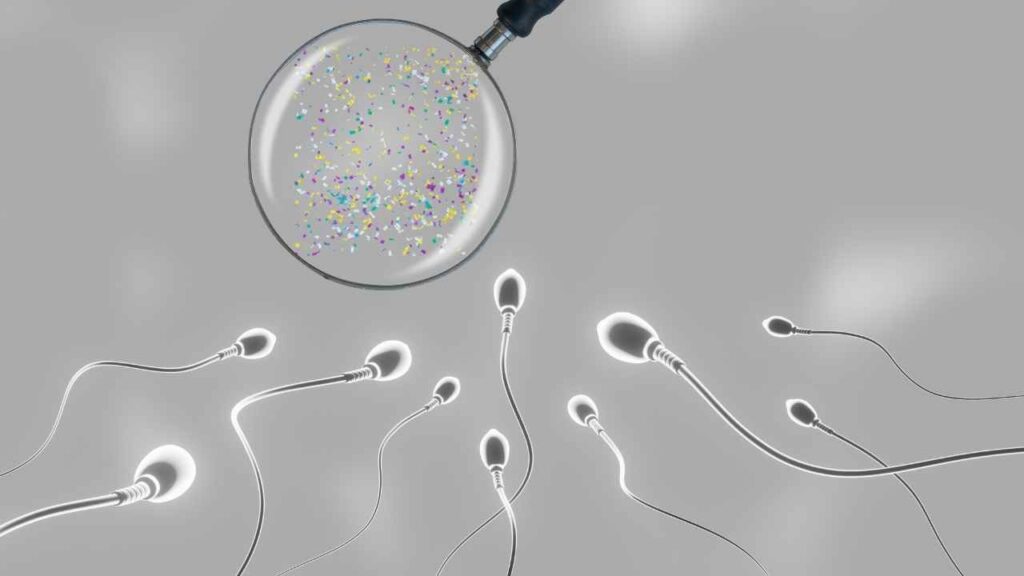In a recent groundbreaking study, a research team in Spain have detected microplastics in human semen and ovarian follicular fluid, raising serious concerns about the impact of environmental pollution on human fertility. The research, presented at the 41st Annual Meeting of the European Society of Human Reproduction and Embryology (ESHRE), is the latest in a growing body of evidence suggesting that microplastic pollution is not only widespread but may be affecting some of the most vital systems of the human body.
Table of Contents
Microplastics Found in Reproductive Fluids
Spanish researchers from the University of Murcia, in collaboration with Next Fertility Murcia, analyzed follicular fluid samples from 29 women and seminal fluid from 22 men undergoing fertility evaluation. They found microplastics in:
- 69 % of follicular fluid samples (egg‑surrounding liquid),
- 55 % of seminal plasma samples.
Using laser direct infrared microscopy, the team identified multiple common polymers, notably:
- PTFE (Teflon), most prevalent: found in 31 % of female samples and 41 % of male samples,
- Followed by PP (28%), PET (17%), PA (14%), polyethylene (PE) (10%), PU (10%), and PS (7%) in female sample and PS (14%), PET (9%), PA (5%), and PU (5%), in male sample.
Concentrations were very low—typically one to two particles per sample—though up to 38 PTFE particles were recorded in one follicular fluid sample.
Related: What is Lyme Disease? The Illness That Justin Timberlake Was Diagnosed With
What Are Microplastics and How Do They Enter the Body?

Microplastics are plastic fragments smaller than 5 millimeters, and they can be found almost everywhere—from oceans and soil to drinking water and even food. These particles enter the human body through three primary routes:
- Ingestion: via food and beverages
- Inhalation: through air particles
- Skin contact: via cosmetics and personal care products
Once in the body, microplastics can enter the bloodstream and get transported to vital organs, including the reproductive system.
Why the Above Findings Matter
Although the concentrations of microplastics were low—often just one or two particles per sample—the implications are potentially serious, especially the location of plastic particles in reproductive fluids is deeply concerning.
Animal research indicates microplastics can trigger inflammation, oxidative stress, cellular aging, and DNA damage. Besides, they can disrupt hormonal balance, reducing sperm count and egg quality.
While the new research did not directly assess fertility outcomes in humans, the presence of these particles in reproductive fluids raises red flags for egg and sperm viability.
Lead researcher Dr. Gómez-Sánchez stated, “Microplastics in reproductive fluids suggest a direct pathway for these pollutants to affect fertility. Although more research is needed, these findings are a wake-up call.”
Broader Context of Microplastics in Human Health
These findings add to a growing body of evidence that microplastics are pervasive in human tissues—from blood, placenta, breast milk, and testicles to lung and brain tissue. A 2025 peer‑reviewed study in Italy earlier confirmed the presence of microplastics in human follicular fluid for the first time, supporting the Spanish outcomes.
Notably, a 2024 Chinese study found microplastics in every human semen sample tested. Another Italian study detected them in 60% of healthy men, while additional research in May 2025 found the particles in all 23 testicle samples examined.

Expert Perspectives and Cautions
Dr. Emilio Gómez‑Sánchez, lead researcher, stated they were not surprised to find microplastics in reproductive fluids but were struck by how prevalent they were. He emphasized no immediate cause for alarm, noting fertility depends on many factors beyond micropolars exposure.
Professor Carlos Calhaz‑Jorge, a past chair of ESHRE, called these findings “an additional argument in favour of avoiding the generalised use of plastics in our daily lives”.
Some scientists, such as Dr. Stephanie Wright, urged caution, reminding readers that while contamination risks were controlled, earlier studies have warned about lab‑borne microplastics skewing results.
Industry Response and Controversy
Despite mounting evidence, not all scientists agree on the implications. Dr. Chris DeArmitt, founder of the Plastics Research Council, argues that the quantities found are too small to be harmful. “Microplastics are non-toxic and exposure levels are extremely low.”
However, other experts disagree. Dr. Luigi Montano of the University of Rome stressed the urgent need for action, warning, “If microplastic pollution is impairing reproduction, it may prove catastrophic for our species.”
Ways to Reduce Exposure
While total avoidance is impossible, experts recommend practical steps to limit personal plastic exposure:
- Use glass or stainless‑steel containers for food and water,
- Avoid microwaving in plastic,
- Limit consumption of bottled water,
- Replace nonstick cookware,
- Skip plastic cutting boards in favour of wood, glass, or bamboo
- Say no to ultraprocessed foods
- Choose natural fiber clothing over synthetic
Dr. Gómez‑Sánchez frames microplastics as one of many factors influencing fertility, suggesting that small lifestyle changes offer a reasonable precautionary approach without alarm.
Looking Forward: What Comes Next?
The authors plan a follow‑up phase involving larger cohorts, detailed lifestyle exposure questionnaires, and direct correlations between microplastic burden and sperm/oocyte quality. They hope to determine whether higher particle counts correspond with poorer fertility outcomes or assisted reproduction success rates.
If brief, the research team plans to:
- Expand the sample size
- Study correlations with lifestyle and environmental exposure
- Investigate the effect of microplastics on egg and sperm quality
Future studies may also explore the potential transgenerational effects of microplastics, including impacts on embryo development and long-term reproductive health.
Parallel research in animal models suggests possible mechanisms—oxidative and hormonal disruption, blood‑testis barrier impairment, and cumulative toxicity—but human data remain scarce.
Global Policy and the Future
Experts are urging governments to move beyond individual responsibility and adopt systemic policy changes. “Federal action on plastic production and recycling is urgently needed,” said Dr. Matthew Campen, a leading researcher in microplastic toxicity.
Plastic production has grown 250-fold in 75 years, and if current trends continue, it’s expected to triple again by 2060. This alarming rise underscores the need for international agreements like the Global Plastics Treaty currently under UN negotiation.
Final Thoughts: Why This Study Deserves Your Attention
The detection of microplastics in reproductive fluids is not just alarming—it’s unprecedented in scope and location. Even at very low concentrations, the presence of synthetic polymers in fluids directly involved in conception merits attention.
While we await more extensive human studies, ongoing research is crucial. Now, this much is clear: reducing plastic use—both at the individual and policy level—is no longer optional.
In a world increasingly dominated by plastic pollution, this 2025 study presented at ESHRE should serve as a reminder that reproductive health and environmental health are deeply intertwined.
References/ Other sources:
- Montano, L., Raimondo, S., Piscopo, M., Ricciardi, M., Guglielmino, A., Chamayou, S., Gentile, R., Gentile, M., Rapisarda, P., Conti, G. O., Ferrante, M., Motta, O., First evidence of microplastics in human ovarian follicular fluid: An emerging threat to female fertility. Ecotox. Environ. Saf., 291, 117868.
- Montano, L., Giorgini, E., Notarstefano, V., Notari, T., Ricciardi, M., Piscopo, M., Motta, M. (2023). Raman Microspectroscopy evidence of microplastics in human semen. Sci. Total Environ. 901, 165922
- Guo, Y., Rong, M., Fan, Y., Teng, X., Jin, L., & Zhao, Y. (2025). The Presence of Microplastics in Human Semen and Their Associations with Semen Quality. Toxics, 13(7), 566.
- Zhang, C., Zhang, G., Sun, K., Ren, J., Zhou, J., Liu, X., Lin, F., Yang, H., Cao, J., Nie, L., Zhang, P., Zhang, L., Wang, Z., Guo, H., Lin, X., Duan, S., Cao, J., & Huang, H. (2024). Association of mixed exposure to microplastics with sperm dysfunction: a multi-site study in China. EBioMedicine, 108, 105369.
- Other Related Reports: News Medical, Eurekalert, Earth.com, EL PAÍS, ctvnews.ca, The Guardian (Rep-1) & (Rep-2), CNN.
